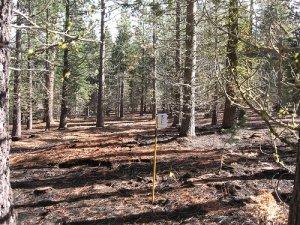We often think of national parks as areas where anything that resembles logging'even limited removal of smaller trees and brush'is prohibited, so officials at Lassen Volcanic National Park want you to know what all the noise is about in the woods at that California park in the next couple of weeks.
The Northwest Gateway Forest Restoration Project, which got underway on February 3, is an effort to reduce to risks to the forest and everything around it from a catastrophic wildfire. It's a strategy already being used around the country, and one whose need was reinforced by last year's huge Rim Fire in and around Yosemite National Park.
According to information from the park, "This fuel reduction project is located in the northwest corner of Lassen Volcanic National Park where forest conditions present a severe risk of high intensity fire. In partnership with Lassen National Forest, a onetime entry with mechanized equipment will be used to reduce live understory and ladder fuels in this popular recreation area. These activities will specifically focus on the reduction of excessive understory tree densities and surface fuel loads previously managed with prescribed fire."
'One hundred years of fire exclusion in Lassen Volcanic National Park has resulted in overly dense and unhealthy forest areas,' stated Park Superintendent Darlene M. Koontz. 'In the absence of surface fires, shade-tolerant white fir have formed dense thickets crowding out old growth pines, aspen stands, and understory shrub and grass vegetation. The process will reduce old-growth mortality rates, promote a more varied stand structure, and restore and protect wildlife habitat.'
A park spokesperson explains that "The overall restoration goal of this treatment strategy is to reestablish a fire adapted forest landscape by restoring a more resilient, diverse forest structure. Once the forest structures and/or surface fuel profiles have been restored, natural and prescribed fire applications can be utilized to further restore, enhance and maintain the system without further use of mechanical equipment."
Ironically, the project is being made possible the dry winter is adding to both the ongoing drought and elevated risk of wildfires in much of the state. Low snow levels in the park have made it possible to get equipment needed for the project into the forest. Unless delays are caused by a significant amount of snow, the project is expected to take about two weeks.
Some might ask whey the park doesn't use prescribed fire rather than mechanical thinning to open up the dense stand? It's a matter of using the right "tool" for the job, and lessons learned from previous prescribed burns. A summary of the project offers a good explanation.

A similar project near the Manzanita Lake Campground illustrates the results of a similar project in the park. NPS photo.
"Research and experience suggest other fire management strategies such as prescribed fire or hand thinning are inadequate tools for the specific needs of this project. Prescribed fire applications in similar conditions have resulted in high intensity fires causing loss of old-growth and excessive understory mortality. A recent small scale mechanical treatment project in the Manzanita Lake Campground area proved successful at restoring the area forest structure."
You can view or download the project summary, which includes more details and a map of the area involved, at this link. Pictures in that document comparing forest conditions at the same location near Manzanita Lake in 1925 and 1995 offer a good illustration of the need for the work.
The Northwest Gateway Forest Restoration project is composed of six areas with a total treatment area of up to 2145 acres. In early February, weather permitting, mechanical thinning will begin in two of the six areas totaling approximately 500 acres.
As the project name suggests, the work will be conducted in the far northwestern corner of the park, near the Highway 89 entrance and adjacent to the boundary with Lassen National Forest. There are no trail or facility closures associated with this project; however visitors in the Manzanita Lake area may see and hear the equipment used for mechanical thinning.
If you need more information about the project, you can contact the park at (530) 595-6102 Monday through Friday from 8:00 a.m. to 4:30 p.m. or visit www.nps.gov/lavo/parkmgmt/nwg.htm.




Add comment